Abstract
Atmospheric drought is an extremely important issue on a global, regional and local scale, especially in the context of climate change. The aim of the study was to assess the spatiotemporal variation of atmospheric (meteorological) drought in agricultural areas of east-central Poland, represented by the Lublin Voivodeship (Lublin region) in 1971–2015. Average monthly air temperatures and monthly precipitation totals recorded over the 45-year period at 25 weather stations were used in the study. The assessment of spatiotemporal variation in atmospheric drought in the study area was based on calculations of the aridity index. The analysis showed an increase in the severity of atmospheric drought in the Lublin region, with intensification of this phenomenon in the last two decades, especially in the warmer half of the year (April, June–August). The main cause of drought in the Lublin region was identified as a statistically significant increase in air temperature (on average, from 0.4 °C to 0.7 °C/10 years in April, July and August, and from 0.2 °C to 0.5 °C/10 years in June) together with the absence of changes in precipitation in the warmer half of the year. This may be linked to some increase in the frequency of high-pressure circulation types, both non-directional and advection from the south. Due to the worsening problem of drought in Poland in recent years, especially in agriculture, there is a need for further research on this subject and for solutions aimed at optimizing agricultural use of the productive environment.
1. Introduction
Global warming, climate change and the increased frequency of extreme weather phenomena, including drought, are among the greatest threats to the modern world [1,2,3].
Agriculture is the sector of the economy that most acutely feels the effects of progressing climate change [4,5]. The increasingly frequent periods of water shortage resulting from drought pose a particular threat to agriculture and the efficiency of agricultural production [6,7].
This issue is especially important in the context of ensuring global food security [8]. According to Wilhite [9], on a global scale, about one-fifth of damage caused by natural disasters can be ascribed to droughts, which have negative effects not only on agriculture and the ecosystem, but on society and the economy as well [4]. Droughts are the cause of malnutrition, hunger, diseases and thus death, depopulation and migration [2,10,11].
The immediate cause of drought is a disturbance of the water balance. The first stage of drought is atmospheric (meteorological) drought, which involves a precipitation deficit (the precipitation is much lower than the norm for a given area). It can last from several weeks to several years. It is often accompanied by high air temperature, which causes a decrease in the relative humidity of atmospheric air. The most common cause of meteorological drought is anticyclonic (high-pressure) circulation and an influx of warm, dry air masses [12,13,14,15].
From the point of view of agriculture, prolonged atmospheric drought contributes to the degradation of the soil and causes it to dry out. It can turn into soil drought (agricultural drought). Long periods without precipitation deplete soil water resources available for plants and exacerbate wind erosion. Agricultural drought seriously limits the growth and development of crop plants, impeding access to nutrients taken up by the root system. It also makes agrotechnical procedures more difficult. It leads to considerable decreases in yield and reduces crop quality, and in extreme cases, to the death of plants [12,16,17,18].
Climate change, including drought, is included among the serious abiotic stressors that can not only have a critical influence on natural ecosystems [19,20] but also cause changes in the species composition of crops and agrophytocoenoses [21]. Drought not only decreases crop yields (including irrigated crops) but also causes changes in crop structure [22]. Moreover, it can lead to the development of plant diseases and pests in natural and agricultural ecosystems [23]. It also poses a serious threat to the soil ecosystem and to biodiversity in the soil [24,25,26,27].
The effects of drought depend on its severity and duration, and have a varied territorial range. Droughts occur in all climate zones, in areas with high or low precipitation levels, and they will increase with climate change [28,29]. An increase in air temperature and potential evapotranspiration can lead to an increase in the occurrence of drought [30].
Poland’s geographic location results in high variation in weather types due to the meeting of moist maritime air masses from the west and dry continental air from the east. Advection of air from the north and south is less common, but in the 21st century, an increase in air flow from the south has been recorded [31]. An influx of tropical air from lower latitudes usually takes place during strong high-pressure systems over Eastern Europe, which, in the warmer half of the year, cause heat waves and periods of drought [32,33]. Several studies have analysed the effect of atmospheric circulation on variation in various meteorological elements in Poland [34,35,36,37,38,39]. It should be noted that, in recent years, numerous studies on the frequency of atmospheric drought have appeared in the Polish literature, but there are significantly fewer dealing with the circulation determinants of this phenomenon. Previous studies on the circulation determinants of drought have not been conducted on a regional scale, but only in the vicinity of a single weather station [14,40,41].
Atmospheric drought is an extremely important issue on a global, regional and local scale. There is currently a lack of scientific research (or only fragmentary research) on drought in agricultural areas of the central part of eastern Poland.
Therefore, the aim of the study was to assess the spatiotemporal variation of atmospheric drought in agricultural areas of east-central Poland and to identify the types of synoptic conditions that generate atmospheric (meteorological) drought.
The study was conducted in the Lublin Voivodeship, also referred to in the paper as the Lublin region. This is a typically agricultural region with the highest proportion of agricultural land in Poland, comprising more than 70.0% of the total area of the voivodeship. In valuation of the climate for agriculture, the study area has been assigned from 92 to 96 points, an agroclimate score that indicates highly favourable conditions for crop production [42].
Average monthly air temperatures and monthly precipitation totals recorded over a 45-year period (1971–2015) at 25 weather stations were used in the study to calculate a drought index.
2. Materials and Methods
2.1. Study Area
The study was conducted in the Lublin Voivodeship (Lublin region), in the central part of eastern Poland. The Lublin Voivodeship has an area of 25.122 km2, which is 8.0% of the total area of the country, and the third largest among its voivodeships. The eastern border of the Lublin Voivodeship with Belarus and Ukraine is also the eastern border of the European Union [43].
The Lublin region is a typical agricultural region. Its favourable conditions for agriculture are mainly due to the favourable soil and climate conditions. The proportion of agricultural land in the total area of the voivodeship is 70%, and 99.3% of the total area of agricultural land is in good agricultural condition. The agricultural quality score of the production environment in the region, taking into account the land relief, soil quality, water conditions, and agroclimate, is 74.1 points (66.6 points for the country overall) and is one of the highest in Poland. Cereals dominate in the crop structure in the Lublin Voivodeship, accounting for over 74% of all crops, followed by industrial crops (over 14%), legumes for grain (about 4%), and fodder crops, which account for about 3% of the total crop structure. The Lublin region is also an important producer of fruit, mainly berries [44].
The northern and south-eastern parts of the Lublin region are lowlands: the Southern Podlasie Lowland and Western Polesie. The Lublin Upland, with fertile soils, stretches across the central and south-western parts. The Volhyn Upland and Volhyn Polesie form the eastern part. A long belt of hills of the Roztocze Upland, the highest part of the voivodeship, rises in the south. Its elevation increases south-eastward from 300 m to about 400 m above sea level (Figure 1) [42].
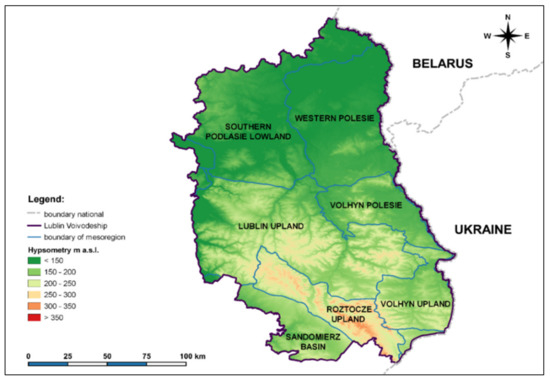
Figure 1.
The Lublin Voivodeship—land relief and division into geographic macroregions.
The topography of the Lublin Voivodeship also differentiates its climate conditions. As seen in Figure 1, the elevation above sea level increases from north to south. Together with atmospheric circulation, this is one of the decisive factors determining the climate conditions in the region.
2.2. Climatic Conditioning of the Study Area
The Lublin Voivodeship is located in the temperate climate zone, a transitional zone between the continental climate (eastern Europe) and the oceanic climate (western Europe), characterized by high variation of weather [45].
Climatic conditions here are shaped by solar and circulation determinants and by the physical geography of the land. The western part of the Lublin Voivodeship is the warmest, with an average annual temperature of 8.5 °C, while the temperature in the east is 7.8 °C. It is coolest in the south-east (at the highest elevation above sea level—over 270 m), with an average annual temperature of 7.4 °C. Temperature conditions affect the length of the growing season, which is 220 days in the western part of the voivodeship, but shorter in the east, on average 212 days. July is the warmest month, with an average temperature from 17.2 °C to 18.5 °C, while January is the coldest, with an average temperature from −4.3 °C to −2.6 °C [45,46].
Precipitation in the Lublin Voivodeship shows high temporal and spatial variation. On an annual basis, precipitation is lower in winter than in summer, and July is the wettest month, with 77 mm average rainfall. The average annual precipitation totals are about 550 mm. They are highest in the south of the voivodeship, ranging from 600 mm to 700 mm [47].
The climate conditions of the Lublin region are largely dependent on atmospheric circulation. On an annual basis, high-pressure (anticyclonic) systems responsible for sunny weather (not conducive to precipitation) are slightly predominant. The percentage share of occurrence of these conditions is about 51%, with considerable dominance from May to October over low-pressure (cyclonic) systems, which are dominant in late autumn and winter (November and December) [45]. Low-pressure systems are conducive to precipitation.
2.3. Research Material
The data used in the study were the average monthly air temperatures and monthly precipitation totals from a 45-year period (1971–2015), obtained from 25 weather stations belonging to the Institute of Meteorology and Water Management (National Research Institute in Warsaw) and the University of Life Sciences in Lublin. Most of the stations were located within the Lublin Voivodeship. To obtain more detailed results, data from stations outside the borders of the voivodeship, but in its immediate vicinity, were included as well. These are data from a weather station in Siedlce (Masovian Voivodeship) and one in Sandomierz (Świętokrzyskie Voivodeship). The locations of the weather stations are shown in Figure 2.
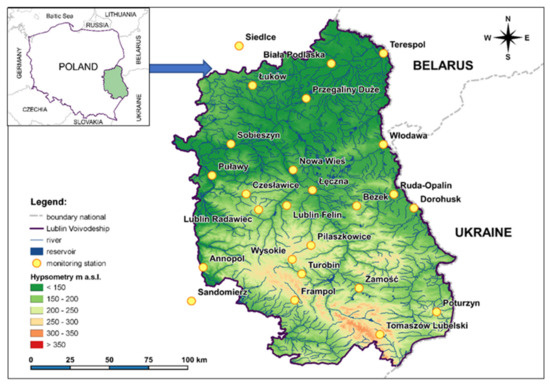
Figure 2.
Locations of the weather stations in the Lublin Voivodeship.
To explain the relationship between atmospheric circulation and drought, an original classification of circulation types was used [48,49]. Determination of the direction of air flow and non-directional patterns was based on the procedures described by Jenkinson and Collinson [50] and Bartoszek [51].There are four directional cyclonic types (N+NEc, E+SEc, S+SWc and W+NWc), four directional transitional types (N+NEo, E+SEo, S+SWo and W+NWo), four directional anticyclonic types (N+NEa, E+SEa, S+SWa and W+NWa), one non-directional cyclonic type (C), one non-directional anticyclonic (A) and one undefined non-directional type (x) (Table 1). The large-scale circulation patterns are also presented in maps of mean sea level pressure over the European continent on days with a given circulation type. The reanalysis daily mean sea level pressure from the National Centre for Environmental Prediction/National Centre for Atmospheric Research (NCEP/NCAR) was used in the construction of the maps [52].

Table 1.
Grouped circulation types used in the study according to Kaszewski et al. [48] and Bartoszek [49].
2.4. Statistical Analysis
In the first stage of the research, to determine the monthly values for the aridity index A [53], also referred to in the literature as the Si index [54] or the Ped index [55], the basic statistical characteristics of the temperature and precipitation conditions were calculated, i.e., the average 45-year monthly air temperature and precipitation total and their standard deviations. The values of the A index were the basis for the assessment of the range and severity of drought in the area in the years 1971–2015. The aridity index A is a synthetic index enabling the spatiotemporal assessment of atmospheric drought in a given region during a long time period (based on long-term data series) [56,57,58].
The aridity index A was calculated as the difference between two partial indices, i.e., the standardized deviations of the average monthly air temperature and the standardized deviations of the monthly precipitation totals. The aridity index A was calculated according to the following formula:
where
- A—aridity index,
- ti—average monthly air temperature in a given month (°C),
- tm—average monthly air temperature in the 45–year period (°C),
- σt—standard deviation of the monthly air temperature (°C),
- Pi—monthly precipitation total in the month (mm),
- Pm—average monthly precipitation total in the 45-year period (mm), and
- σp—standard deviation of the monthly precipitation total (mm).
Depending on the value of the A index, each month was assigned to a class, adopting the classification according to Koleva and Alexandrov [56]:
| wet months | A < −1 |
| optimal months | −1 ≤ A < 1 |
| dry months | A > 1; |
Within this class, the following were distinguished:
| months with signs of drought | 1 ≤ A < 2 |
| months with moderate drought | 2 ≤ A < 3 |
| months with severe drought | A ≥ 3 |
The aridity index A has positive values in the dry and warm periods due to the positive deviations of air temperature and negative deviations of monthly precipitation. The index is negative for the wet and cold periods due to the negative deviation of average monthly air temperature and positive deviation of precipitation totals [55,59].
In the next stage of the research, the frequency of each A index class was calculated. Based on these frequencies, the proportion of dry months (with varying degrees of drought, i.e., with values A > 1: classes 1 ≤ A < 2; 2 ≤ A < 3; and A ≥ 3, was determined for the growing season (April–September).
The temporal variation in the phenomenon of atmospheric drought in the Lublin region in 1971–2015 was analysed as well. To this end, the average values for the aridity index A in each year of the 45-year period were calculated for each measurement station and then for the entire study area.
Trends of changes in the aridity index A, as well as in air temperature and precipitation (i.e., the components of the formula for the index), were analysed. In addition, the statistical significance of the trends was determined. The computations were made using the non-parametric Mann–Kendall test for identifying decreasing or increasing trends in a series of data [60].
The Mann–Kendall test statistic S was calculated from the following formula:
where
- xj and xi—value of the variable in year j and in year i, where j > i, and
- n—length of the sequence.
The normalized test statistic Z was calculated from the following formula:
Trends are increasing when the value of Z is greater than 0 and decreasing when the result is negative.
The null hypothesis is rejected when the absolute value of Z is greater than the theoretical value of the normal distribution , where α is the level of significance (for the significance level of α = 0.05, ).
For data for which an increasing or decreasing trend were found, the magnitude of the changes was estimated by calculating Sen’s slope estimator [61], according to the following formula:
The statistical computations were conducted using MAKESENS software [62]. Selected results of statistically significant trends are presented in maps.
Quantum GIS software was used for the graphic illustrations in the form of maps. Inverse distance weighting (IDW) was used to present the spatial distribution of temperature and precipitation and the driest months. This is an interpolation method in which values in a given location are determined on the basis of known values of points located nearby, where the points have an assigned weight depending on the distance between them. The closer the point of known value to the location whose value is to be determined, the greater its weight is [63].
The “Calendar of circulation types over the Lublin region” developed by Bartoszek [49] was used to identify the synoptic conditions responsible for the occurrence of atmospheric drought in the agricultural region of east-central Poland The frequency of circulation types and deviations of temperature and precipitation from the long-term averages were calculated only in the warmer half of the year (the growing season). Based on these calculations, circulation types that may be conducive to the occurrence of atmospheric (meteorological) drought were identified. Next, temporal trends for synoptic conditions in the warm half–year (April–September) were determined based on Kendall’s non-parametric τ-coefficient of correlation, calculated using Statistica 13 software (StatSoft Polska). These characteristics are presented in tables and graphs.
3. Results
In the period of 1971–2015, the average air temperature in the Lublin region in the warmer half of the year (April–August) ranged from 13.9 °C in the southeast to 15.1 °C in the west. The average precipitation totals showed greater variation in that period—from 340 mm in the north of the region to 430 mm in the south (Figure 3). Their distribution was clearly linked to the land relief of the Lublin Voivodeship and its elevation above sea level (Figure 2).
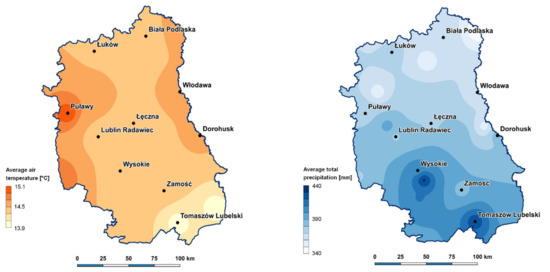
Figure 3.
Average air temperature and precipitation totals in the Lublin region in the warmer half of the year in 1971–2015.
3.1. Frequency of Occurrence of Aridity Index A Classes
The paper presents the frequency of each class of aridity index A for the warmer half-year, i.e., the growing season, but the temperature and precipitation conditions of the colder half of the year were analysed as well, due to their importance for soil water resources at the start of the growing period.
The values of this index showed spatial and temporal variation (Figure 3). On a yearly scale, the average frequency of months with varying degrees of drought was about 27%. It was somewhat higher (28%) in the warmer half of the year (April–September) than in the colder half (26%) (October–March) (Figure 4).
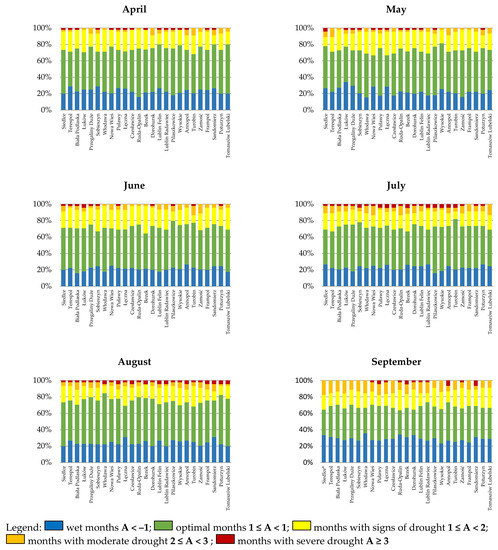
Figure 4.
Frequency of each class of aridity index A in the warm half-year in the Lublin region (1971–2015).
The analysis of the frequency of each class of aridity index A showed that optimal conditions (–1 ≤ A < 1) predominated. Comparison of the frequency of dry (A ≥ 1) and wet (A ≤ –1) conditions in the 45-year period revealed that dry conditions were more common. In all months, signs of drought in the range of 1 ≤ A < 2 were most common, with the greatest risk of moderate (2 ≤ A < 3) and severe (A ≥ 3) drought in the study area observed in July and August (Figure 4, Figure A1).
Figure 5a presents the average annual values for the aridity index A from the period of 1971–2015. The temporal variation in this index coincided with the course of the average annual air temperature (Figure 5b). In the years 2000–2015, positive values for the index predominated, with a trend coinciding with the course of the air temperature.
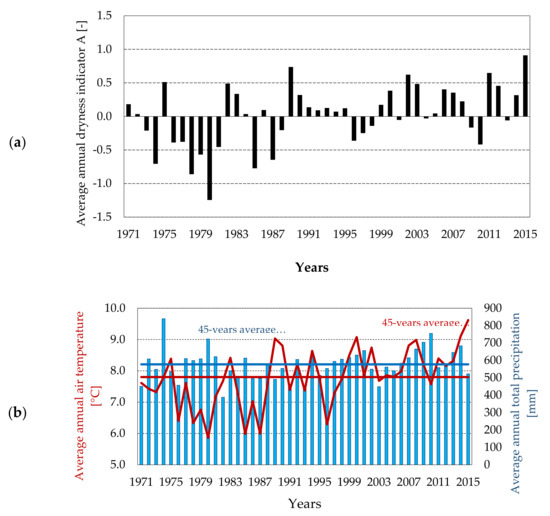
Figure 5.
Average annual values for the aridity index A (a) and air temperature (red line) and precipitation totals (blue bars) (b) in the Lublin region (1971–2015).
In the years 1971–2015 there was moderate or severe drought in the study area, with little spatial variation. Examples of months with atmospheric drought of varying severity throughout the Lublin region are presented in Figure A2.
3.2. Trends of Changes in Aridity Conditions
- (a)
- trends in the aridity index A
The correlation coefficients (Z) of the Mann–Kendall trend for the aridity index A in the warm half of the year indicated a significant increase in the A index at all weather stations in April, June, July, and August. The strongest positive trend (α = 0.01 and α = 0.001) was observed in June and August, and a weaker trend in April and July (α = 0.05 and α = 0.01) (Figure 6, Table A1). As there was an increasing trend for the aridity index A in April, the temporal tendencies of this index in the colder half of the year (October–March) were analysed as well (Table A1). In this half of the year an increasing trend for the A index was observed at only three weather stations—in January at Lublin-Radawiec, Nowa Wieś and Ruda Opalin and in November at Wysokie, Turobin and Zamość.
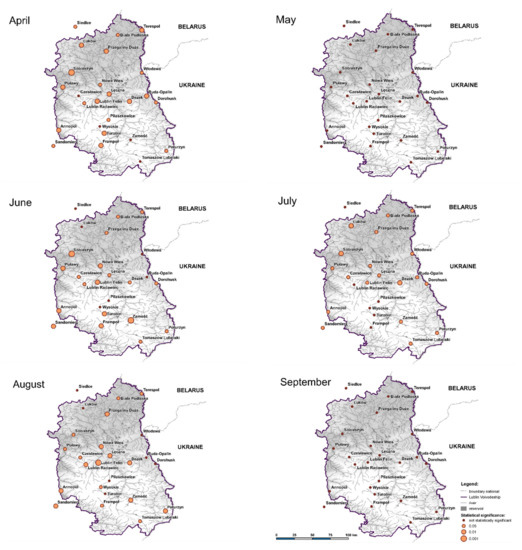
Figure 6.
Statistical significance of the trend (Z) for aridity index A in the months of the warmer half-year in the Lublin region (1971–2015).
- (b)
- trends in average monthly air temperature
The values calculated for the trend coefficients (Z) showed a statistically significant increase in air temperature in April, June, July, August and November (Figure 7). A positive trend in temperature was noted in the remaining months of the year, but it was not statistically significant. The values of the trend coefficients (Z) for all months are included in Table A2.
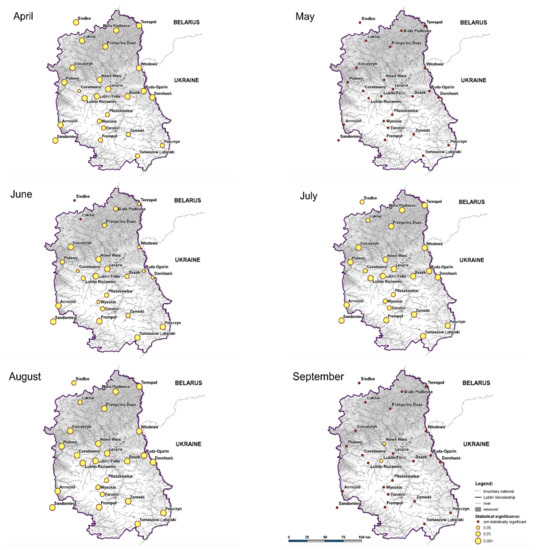
Figure 7.
Statistical significance of the trend (Z) for air temperature in the months of the warmer half-year in the Lublin region (1971–2015).
Sen’s slope estimator (S) in these months was used to estimate the increase in air temperature, which ranged from 0.4 °C to 0.7 °C/10 years in April, July and August, and from 0.2 °C to 0.5 °C/10 years in June.
- (c)
- trends in precipitation totals
During the warmer half of the year, a significant increase in precipitation was observed only in May (at 13 weather stations) (Figure 8). In the remaining months of the warmer half of the year (April–September), no statistically significant changes in the precipitation totals were noted. The small negative and positive values for the trend coefficient Z in April and from June to September indicate weak trends in the precipitation totals in the study area (Table A3). As in the case of aridity index A, trends in the monthly precipitation totals were calculated for the colder half of the year (Table A3). Statistically significant increasing trends in precipitation were observed only in January (at 19 stations), February (at 11 stations) and March (at 18 stations), while a decreasing trend was noted in December (at 2 stations) (Table A3 and Figure A4). In the colder half of the year, positive trends (Z) in monthly precipitation totals were observed at most stations (Table A3, Figure 8).
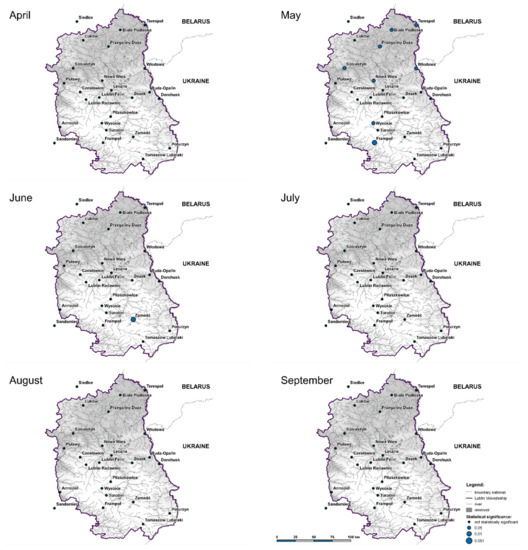
Figure 8.
Statistical significance of the trend (Z) for precipitation in the months of the warmer half-year in the Lublin region (1971–2015).
Based on Sen’s slope estimator (S), it was estimated that the increase in precipitation totals ranged from 5.0 to 8.0 mm/10 years in May, and from 3.0 to 7.0 mm/10 years from December to March.
3.3. Circulation Determinants of Atmospheric Drought
In east-central Poland (the Lublin region), anticyclonic synoptic conditions determining an inflow of dry continental air from the east were quite frequent, as was type A circulation, corresponding to the formation of a high-pressure system over Central Europe (Table 2, Figure 9).

Table 2.
Frequency (%) of circulation types over the Lublin region in the warm half of the year (April to September) (1971–2015).
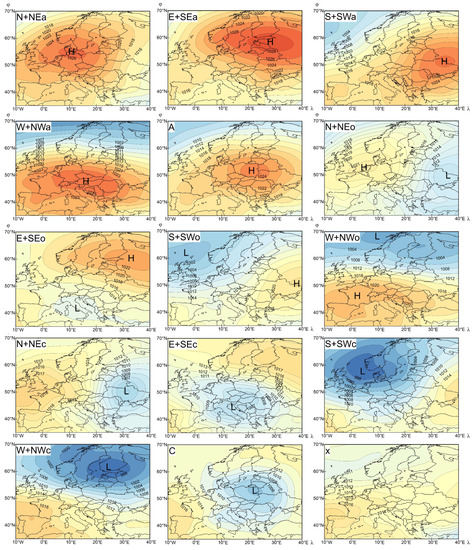
Figure 9.
Circulation types over Poland [52]. L—the center of low pressure system; H—the center of high pressure system.
In the warmer half of the year, anticyclonic conditions determining an influx of dry continental air from the east and type A conditions corresponding to a high-pressure system over Central Europe were quite common over east-central Poland (the Lublin region) (Table 2, Figure 9).
From April to September, there was also a large share of synoptic conditions with advection of air from the west and north-west (cyclonic and transitional types). They were accompanied by an increase in cloud cover and an inflow of colder air from the North Atlantic. In the months of the warmer half-year in the Lublin region, cyclonic conditions were most predominant over the anticyclonic conditions in April and June, while anticyclonic conditions were clearly dominant in August (Table 2).
Figure 10 presents the average deviations of air temperature, precipitation totals and mean values of the aridity index A from the long-term average during days with specific circulation types in the period from April to September. Temperature conditions depended more on the direction of the inflow of air than on the pressure system (warming during advection from the east and south, cooling when air flows from the west and north). In the case of deviations of precipitation, the deciding factor is the type of circulation–cyclonic (higher precipitation) or anticyclonic (conditions conducive to drought). The greatest positive deviations of temperature from the average are noted in July, and the greatest negative rainfall deviations appeared in July and August (Figure 10). These deviations are associated with the occurrence of anticyclonic and transitional circulation types determining an inflow of air masses from the south and east (e.g., S+SWa; E+SEa; E+SEo) and the non-directional anticyclonic type A (Figure 9).
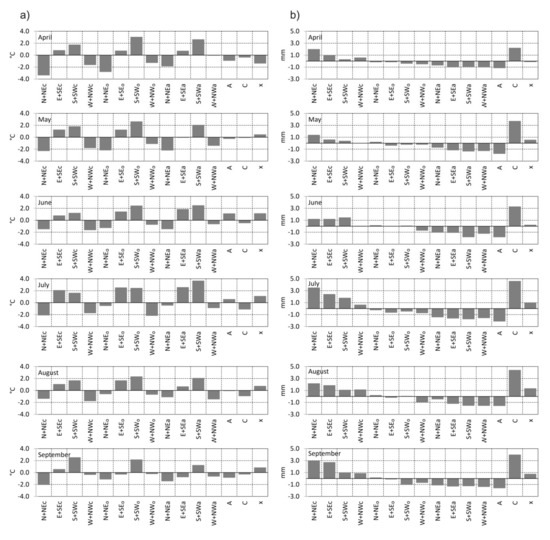
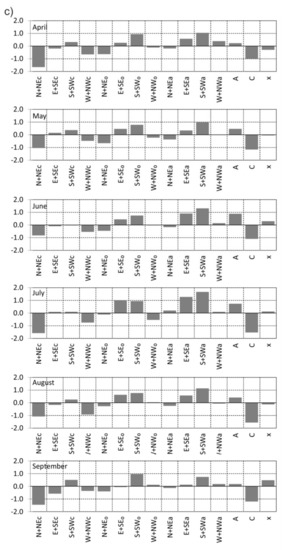
Figure 10.
Deviations from the long-term average air temperature (a), monthly precipitation totals (b) and mean values of the aridity index A (c) during the occurrence of various circulation types (1971–2015).
The previously noted statistically significant increasing trend of the aridity index A corresponds to an increase in the frequency of some circulation types conducive to periods of drought. During the study period (1971–2015), in the warm half of the year, there was an increase in the number of days with this type of circulation in April (type S+SWo, τ = +0.28), June (A; τ = +0.29), July (S+SWo; τ = +0.39) and September (E+SEo, τ = +0.22). It should be noted that, at the same time, the frequency of types distinguished by below-average temperature and/or positive rainfall deviations decreased (e.g., in July N)+NEc, τ = −0.27; W+NWo; τ = −0.22 (Figure 11).

Figure 11.
Number of days with circulation types whose frequency changed statistically significantly in the months of the warmer half-year in 1971–2015.
4. Discussion
In recent years, droughts have occurred in Poland with increasing frequency and intensity, and have covered large areas of the country. This tendency is consistent with the global trend of extreme meteorological phenomena induced by natural and anthropogenic factors [64,65]. In the last 20 years in Poland, droughts of major economic importance have been recorded in the years 2000, 2002, 2003, 2006, 2015, 2016, 2018 and 2019 [66]. In the Lublin region, there were droughts in the years 1975, 1982, 1989, 2000, 2002, 2003, 2006, 2011, 2012 and 2015, and this phenomenon has intensified in the last two decades.
The negative effects of drought are particularly evident in agriculture. Warm winters without snow are not conducive to the accumulation of water resources in the soil and lead to water shortages even at the start of the growing season. At the same time, hot summers and below-average rainfall or a lack of rainfall increase the risk of drought. The response to drought depends on the plant species, type of soil, land cover and geographic region. In Poland, autumn and early-spring droughts reduce the yield of winter crops, while spring droughts reduce yields of spring cereals. Summer droughts adversely affect the yields of potatoes and fodder crops [64].
Analysis of the occurrence of drought in east-central Poland based on the aridity index revealed that, among dry months (A ≥ 1) in the warmer half of the year, months with signs of drought (1 ≤ A < 2) predominated, while months with severe drought (A ≥ 3) were the least frequent. These results are consistent with research by Szyga-Pluta [67], who found that extremely dry periods in Poland are the least frequent, and less severe droughts are most common.
The increase in the frequency of drought in agricultural areas of the Lublin region is confirmed by the statistically significant increasing trends obtained for the aridity index A in the warmer half of the year (April, June, July and August). The highest frequency of severe drought (A ≥ 3) was observed in July and August, i.e., the months of the warm half-year, in which weather conditions have a decisive impact on the yield and quality of many crop species.
During the 45-year study period (1971–2015), there were also statistically significant increasing trends in air temperature in August and July, with no tendency of changes in precipitation, which showed a significant increase only in May. Increasing trends of precipitation totals were observed only in the colder half of the year, from December to March. This is a positive phenomenon in terms of soil water resources in the spring, i.e., in the onset of the growing season, and may mitigate the effects of atmospheric drought in April.
The increasing trends in the aridity index A observed in our study, which are a consequence of the significant increase in air temperature and lack of changes in precipitation, are linked to circulation determinants in the study area.
The analysis of circulation determinants in the Lublin region (1971–2015) confirms, to some extent, that the overall meteorological conditions and changes in atmospheric circulation can increase the occurrence of drought in the region. Bartoszek and Skiba [68], and Bartoszek [69] also found that, among circulation types over the Lublin region during periods without rainfall, anticyclonic types were the most likely to occur, while cyclonic types were the least likely. The occurrence of these circulation types is conducive to persistence of high air temperature due to light cloud cover and advection of warm air masses from lower latitudes [39]. The dominance of high-pressure systems shaping the weather in this part of Europe is associated with increasingly frequent heat waves that intensify the phenomenon of atmospheric drought [15,70]. An increase in the frequency of anticyclonic circulation types over Central Europe in summer in the 21st century was demonstrated by Hoy et al. [71] and Fleig et al. [72]. This may be due to feedback between the land surface and the atmosphere during dry, warm years [73].
The results of our study conducted for east-central Poland are in line with the findings of other authors. Kożuchowski and Żmudzka [74], Michalska [75], Kundzewicz [76], Skowera et al. [77], Twardosz [78] and Wypych et al. [79] noted an increase in the average annual air temperature. According to Kossowska-Cezak [80], the increase in the average temperature resulted in markedly shorter winters and longer summers. Wójcik and Miętus [81] demonstrated that, in the years 1951–2010, the average warming rate was slightly higher than 0.2 °C/10 years. There was an increasing trend in spring (0.4 °C/10 years) and summer (0.2 °C/10 years), and in the case of individual months, in February (over 0.5 °C/10 years), in the spring months, and in July and August.
Ziernicka-Wojtaszek [82] demonstrated a statistically significant increase in air temperature in the growing season of the years 1981–2016 (in June, July and August), with non-significant increasing tendencies in rainfall.
These questions take on particular importance in the context of climate change, whose main manifestation is a systematic increase in the average global air temperature, which causes the intensification of extreme atmospheric phenomena, including droughts [83,84,85,86].
In the period from 1880 to 2012, the average global temperature increased by 0.85 °C [65]. In the years 1906–2005, it increased by 0.74 °C [1], on average, about 0.06–0.07 °C/10 years. However, in the second half of this period, the rate of warming was nearly twice as high—0.13 °C/10 years.
Increased air temperature, droughts and weather anomalies are the main challenges for global agricultural production [87].
In terms of crop production, an increase in temperature and below-normal or no precipitation lead to a decrease in soil water resources and have an adverse effect on seasonal and yearly evapotranspiration.
The requirements of plants in terms of moisture conditions change during the growing season. In Poland, cereals have the greatest demand for water in the flowering period, potatoes in the period from bud formation to flowering, and maize from the start of tasselling to flowering [88].
An increase in air temperature can alter crop distribution and cause an influx of invasive species, weeds, diseases and pests, which affects crop yields [21,23]. It is difficult to estimate the scale of this phenomenon, because each species and cultivar has different adaptive capabilities and a different range of temperature and moisture requirements. The temperature requirements of selected species have been described by Hatfield et al. [89,90].
Above-average temperatures usually have adverse effects on physiological processes and cause reductions in the yield of many crop species [91,92,93]. According to Hatfield et al. [90], an increase in temperature can lead to a 2.5–10% reduction in yield, and in the case of rice (one of world’s main food staples), a one-degree increase in temperature reduces yield by about 10% [1]. In Poland, the potential decrease in yields of grain and root plants may reach as high as 20% [59,94].
Atmospheric drought poses a serious threat to crop production in the agricultural areas of east-central Poland, where agriculture is the dominant branch of the economy. The results of our study confirm the increasing frequency and severity of atmospheric drought and thus agricultural drought in these areas. The increasing trend in air temperature in the study area was accompanied by an increase in the severity of atmospheric drought. The aridity index A (Ped index) used in the study [53], which takes into account both air temperature and precipitation, is a useful indicator for the spatiotemporal assessment of atmospheric drought [54,55,56,57,58,59]. Due to the severity of drought in Poland, an innovative monitoring system of the effects of agricultural drought has been created [95]. Based on the climatic water balance and the retention properties of soils, this system identifies areas where losses in crops have occurred.
5. Conclusions
- Analysis of the aridity index A showed an increase in the frequency of atmospheric drought in the Lublin region during the study period (1971–2015). This increase was accelerated in the years 2001–2015.
- An increase in drought intensity was confirmed by the statistically significant increasing trends in the aridity index A in April, June, July and August.
- The main cause of atmospheric drought in the Lublin region was identified as a statistically significant increase in air temperature with no tendency of change in precipitation in the warmer half of the year.
- The occurrence of atmospheric drought can be linked to atmospheric circulation. Convergence was observed between the increasing trend of the aridity index A in several months of the warm half-year (April, June–August) and the positive trend of some anticyclonic and transitional circulation types conducive to advection of air from the east and south. The relationships, however, are not very clear, and thus require further, in-depth analysis.
Author Contributions
Conceptualization, B.S. and Ł.K.; methodology, B.S. and K.B.; validation, A.B. and A.W.; formal analysis, B.S., A.B. and K.B. writing—original draft preparation, B.S., A.B., K.B. and A.W.; writing—review and editing, B.S., A.B. and A.W.; visualization, Ł.K.; supervision, B.S. and K.B. All authors have read and agreed to the published version of the manuscript.
Funding
This research was funded by Science Development Fund, number PB/26/2020, Pope John Paul II State School of Higher Education, Biała Podlaska, Poland.
Data Availability Statement
Data sets for this research are included in the References.
Conflicts of Interest
The authors declare no conflict of interest.
Appendix A
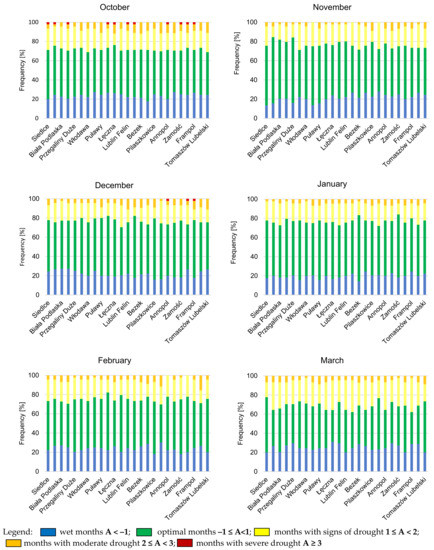
Figure A1.
Frequency of each class of aridity index A in the colder half-year in the Lublin region (1971–2015).
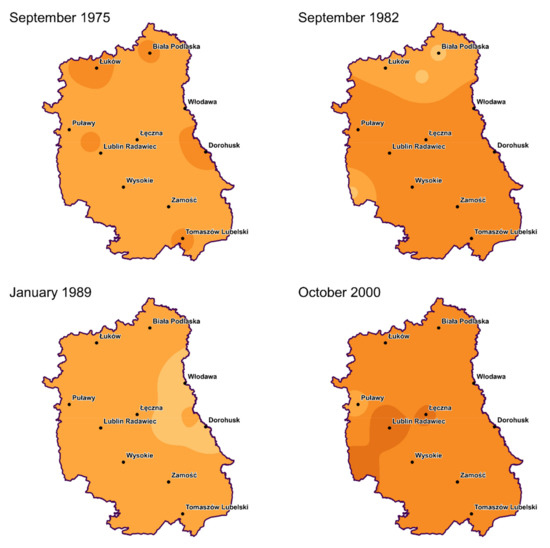
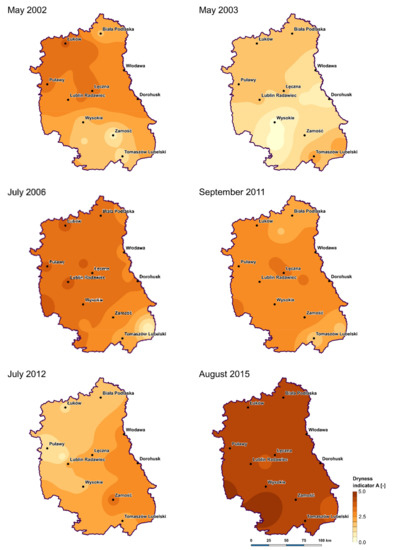
Figure A2.
Spatial distribution of the aridity index A in selected months during the driest years in 1971–2015.

Table A1.
Magnitude of trends in the aridity index A at weather stations in the Lublin region (1971–2015).
Table A1.
Magnitude of trends in the aridity index A at weather stations in the Lublin region (1971–2015).
| Weather Stations | Jan | Feb | Mar | Apr | May | Jun | Jul | Aug | Sep | Oct | Nov | Dec |
|---|---|---|---|---|---|---|---|---|---|---|---|---|
| Siedlce | −1.32 | −1.14 | −0.58 | 2.16 * | −1.07 | 1.48 | 1.87 | 1.63 | 1.34 | 2.01 * | 1.07 | −0.19 |
| Terespol | −1.46 | −0.69 | −0.38 | 2.61 ** | −0.56 | 2.35 * | 2.18 * | 2.16 * | 1.24 | 1.24 | 1.01 | 0.34 |
| Biała Podlaska | −2.13 * | −1.81 | −0.27 | 2.44 * | −0.23 | 2.28 * | 2.26 * | 2.34 * | 1.41 | 1.53 | 0.43 | −0.92 |
| Łuków | −1.55 | −1.65 | −0.52 | 2.82 ** | −1.18 | 1.04 | 2.70 ** | 1.91 | 1.57 | 2.11 * | 0.70 | −0.52 |
| Przegaliny Duże | −1.39 | −0.46 | −0.13 | 2.72 ** | −0.90 | 2.52 * | 2.03 * | 2.74 ** | 1.06 | 1.37 | 0.88 | −0.54 |
| Sobieszyn | −1.30 | −0.58 | −0.46 | 3.53 *** | −0.75 | 3.53 *** | 2.81 ** | 2.38 * | 1.36 | 1.59 | 0.40 | 0.00 |
| Włodawa | −1.03 | −0.52 | −0.24 | 2.40 * | −0.69 | 1.81 | 2.28 * | 1.46 | 1.69 | 1.42 | 1.16 | 0.11 |
| Nowa Wieś | −2.22 * | −1.53 | −1.59 | 2.17 * | −0.35 | 2.94 ** | 2.15 * | 3.23 ** | 1.61 | 1.59 | 0.62 | −1.26 |
| Puławy | −1.20 | −0.87 | −0.77 | 3.02 ** | −0.58 | 2.60 ** | 2.26 * | 2.51 * | 1.20 | 1.24 | 1.01 | 0.32 |
| Czesławice | −1.48 | −0.66 | −1.52 | 1.95 | −0.85 | 2.22 * | 2.30 * | 2.49 * | 0.83 | 1.05 | 0.95 | 1.02 |
| Łęczna | −0.43 | −1.04 | −0.76 | 2.93 ** | 0.41 | 2.47 * | 2.54 * | 2.71 ** | 1.32 | 0.98 | 1.37 | −0.04 |
| Ruda-Opalin | −1.67 | −1.22 | −1.08 | 2.62 ** | 0.11 | 1.14 | 1.99 * | 1.57 | 1.35 | 1.47 | 0.54 | −1.39 |
| Lublin Felin | −1.69 | −0.64 | −1.22 | 3.14 ** | 0.00 | 3.02 ** | 2.08 * | 3.49 *** | 1.42 | 1.71 | 1.42 | 0.17 |
| Lublin Radawiec | −1.59 | −0.83 | −1.52 | 2.24 * | −0.11 | 2.36 * | 1.67 | 3.26 ** | 1.36 | 1.30 | 1.18 | 0.28 |
| Bezek | −0.98 | −0.11 | −0.80 | 2.60 ** | 0.15 | 2.12 * | 2.73 ** | 3.16 ** | 0.41 | 1.17 | 1.30 | 1.39 |
| Dorohusk | −1.18 | −0.99 | −0.83 | 2.26 * | 0.30 | 2.40 * | 2.47 * | 1.79 | 0.89 | 1.12 | 0.73 | −0.39 |
| Pilaszkowice | −1.02 | −0.48 | −0.86 | 2.28 * | −0.78 | 1.14 | 1.35 | 1.59 | 0.70 | 0.88 | 1.30 | 0.54 |
| Wysokie | −1.11 | −0.90 | −1.70 | 1.71 | −0.54 | 1.95 | 1.34 | 2.34 * | 0.54 | 1.09 | 1.65 | −0.17 |
| Annopol | −0.64 | 0.00 | −0.48 | 2.65 ** | 0.58 | 2.98 ** | 2.44 * | 2.81 ** | 0.91 | 1.40 | 1.26 | 0.56 |
| Turobin | −0.09 | 0.09 | −0.23 | 2.94 ** | 0.03 | 2.68 ** | 1.79 | 1.30 | 0.96 | 1.24 | 1.83 | 1.63 |
| Zamość | 0.03 | 0.23 | −0.35 | 1.79 | −0.31 | 3.61 *** | 2.19 * | 3.13 ** | 1.49 | 1.59 | 1.65 | 0.86 |
| Sandomierz | −0.42 | 0.28 | −0.64 | 2.46 * | 0.44 | 2.98 ** | 2.38 * | 2.98 ** | 0.66 | 0.97 | 1.14 | 0.32 |
| Frampol | −1.32 | −0.91 | −1.07 | 2.65 ** | −1.12 | 3.02 ** | 1.93 | 2.49 * | 1.38 | 1.12 | 0.87 | 1.14 |
| Poturzyn | −0.95 | −0.28 | −0.99 | 2.17 * | 0.05 | 2.32 * | 2.12 * | 2.73 ** | 0.77 | 0.30 | 0.89 | 0.40 |
| Tomaszów Lubelski | −2.44 * | −1.63 | −1.67 | 1.59 | −0.09 | 2.26 * | 2.20 * | 1.97 * | 0.28 | 0.66 | 0.07 | −0.44 |
* significant at α = 0.05, ** significant at α = 0.01, *** significant at α = 0.001.

Table A2.
Magnitude of trends in air temperature at weather in the Lublin region (1971–2015).
Table A2.
Magnitude of trends in air temperature at weather in the Lublin region (1971–2015).
| Weather Stations | Jan | Feb | Mar | Apr | May | Jun | Jul | Aug | Sep | Oct | Nov | Dec | Apr-Sep | Oct-Mar |
|---|---|---|---|---|---|---|---|---|---|---|---|---|---|---|
| Siedlce | 0.96 | 0.39 | 0.77 | 3.49 *** | 0.38 | 1.70 | 2.74 ** | 3.16 ** | 1.77 | 0.85 | 1.75 | 0.45 | 4.21 *** | 1.60 |
| Terespol | 0.87 | 0.63 | 0.97 | 3.32 *** | 0.67 | 2.48 * | 3.81 *** | 3.55 *** | 1.78 | 1.04 | 2.19 * | 0.53 | 4.92 *** | 1.76 |
| Biała Podlaska | 0.96 | 0.52 | 0.87 | 3.59 *** | 1.24 | 2.95 ** | 3.75 *** | 3.49 *** | 1.48 | 1.14 | 1.96 * | 0.05 | 4.98 *** | 1.30 |
| Łuków | 0.67 | 0.16 | 0.42 | 3.56 *** | 0.66 | 1.69 | 2.75 ** | 2.82 ** | 1.50 | 1.11 | 1.57 | 0.02 | 4.07 *** | 1.25 |
| Przegaliny Duże | 0.67 | 0.31 | 0.52 | 3.62 *** | 1.45 | 2.89 ** | 3.75 *** | 3.49 *** | 1.48 | 1.14 | 1.96 * | 0.05 | 4.98 *** | 1.30 |
| Sobieszyn | 1.08 | 0.53 | 0.86 | 4.01 *** | 1.67 | 3.94 *** | 3.86 *** | 3.85 *** | 1.94 | 1.24 | 2.24 * | 0.62 | 5.37 *** | 1.72 |
| Włodawa | 0.99 | 0.51 | 0.95 | 3.40 *** | 0.89 | 2.54 * | 3.83 *** | 3.74 *** | 1.65 | 1.47 | 2.38 * | 0.53 | 4.98 *** | 1.86 |
| Nowa Wieś | 0.58 | 0.23 | 0.50 | 3.87 *** | 1.73 | 3.41 *** | 4.28 *** | 4.37 *** | 1.97 * | 1.81 | 2.15 * | −0.06 | 5.35 *** | 1.35 |
| Puławy | 0.76 | 0.33 | 0.35 | 3.68 *** | 1.11 | 3.21 ** | 3.42 *** | 3.47 *** | 1.19 | 0.75 | 2.20 * | 0.23 | 4.78 *** | 1.12 |
| Czesławice | 0.40 | 0.09 | −0.29 | 2.45 * | 0.15 | 2.07 * | 2.96 ** | 3.46 *** | 1.07 | 0.88 | 1.97 * | 0.12 | 3.70 *** | 0.55 |
| Łęczna | 1.08 | −0.20 | 0.56 | 3.60 *** | 1.73 | 3.37 *** | 3.88 *** | 3.89 *** | 1.86 | 1.41 | 1.89 | −0.26 | 5.16 *** | 1.43 |
| Ruda-Opalin | 0.70 | 0.28 | 0.61 | 3.56 *** | 1.11 | 2.44 * | 3.77 *** | 3.42 *** | 1.34 | 1.74 | 2.17 * | 0.10 | 4.76 *** | 1.50 |
| Lublin Felin | 1.16 | 0.48 | 0.66 | 3.82 *** | 1.83 | 3.76 *** | 4.39 *** | 4.50 *** | 2.16 * | 1.75 | 2.63 ** | 0.67 | 5.70 *** | 2.26 * |
| Lublin Radawiec | 0.86 | 0.19 | 0.34 | 3.39 *** | 0.98 | 3.00 ** | 3.76 *** | 4.19 *** | 1.79 | 1.19 | 2.31 * | 0.55 | 5.08 *** | 1.37 |
| Bezek | 0.39 | 0.93 | 0.69 | 3.60 *** | 1.61 | 3.00 ** | 4.75 *** | 4.83 *** | 0.66 | 0.87 | 2.49 * | 0.75 | 5.44 *** | 1.60 |
| Dorohusk | 0.99 | 0.51 | 0.95 | 3.40 *** | 0.89 | 2.54 * | 3.83 *** | 3.74 *** | 1.65 | 1.47 | 2.38 * | 0.53 | 4.98 *** | 1.86 |
| Pilaszkowice | 0.81 | 0.38 | 0.29 | 3.29 ** | 0.92 | 2.60 ** | 3.00 ** | 3.03 ** | 0.87 | 0.61 | 2.30 * | 0.23 | 4.01 *** | 1.40 |
| Wysokie | 0.72 | 0.58 | 0.00 | 3.27 ** | 1.24 | 2.46 * | 2.87 ** | 3.27 ** | 0.50 | 0.71 | 2.28 * | 0.67 | 3.97 *** | 1.58 |
| Annopol | 1.23 | 0.54 | 0.58 | 3.89 *** | 1.50 | 3.71 *** | 3.62 *** | 3.85 *** | 1.56 | 1.31 | 2.58 ** | 0.76 | 5.22 *** | 1.97 * |
| Turobin | 0.81 | 0.38 | 0.29 | 3.29 ** | 0.92 | 2.60 ** | 3.00 ** | 3.03 ** | 0.87 | 0.61 | 2.30 * | 0.23 | 4.01 *** | 1.40 |
| Zamość | 0.63 | 0.12 | 0.39 | 3.15 ** | 1.35 | 3.28 ** | 4.24 *** | 4.50 *** | 1.63 | 1.65 | 2.33 * | −0.02 | 5.34 *** | 1.27 |
| Sandomierz | 1.23 | 0.54 | 0.58 | 3.89 *** | 1.50 | 3.71 *** | 3.62 *** | 3.85 *** | 1.56 | 1.31 | 2.58 ** | 0.76 | 5.22 *** | 1.97 * |
| Frampol | 0.92 | 0.31 | 0.73 | 3.02 ** | 1.07 | 3.36 *** | 4.31 *** | 4.78 *** | 1.88 | 1.38 | 2.51 * | 0.39 | 5.54 *** | 1.62 |
| Poturzyn | 0.73 | 0.13 | 0.30 | 2.80 ** | 1.14 | 3.47 *** | 4.12 *** | 4.50 *** | 0.90 | 0.45 | 2.14 * | −0.08 | 5.17 *** | 0.87 |
| Tomaszów Lubelski | 0.73 | 0.13 | 0.30 | 2.80 ** | 1.14 | 3.47 *** | 4.12 *** | 4.50 *** | 0.90 | 0.45 | 2.14 * | −0.08 | 5.17 *** | 0.87 |
* significant at α = 0.05, ** significant at α = 0.01, *** significant at α = 0.001.

Table A3.
Magnitude of trends in precipitation at weather stations in the Lublin region (1971–2015).
Table A3.
Magnitude of trends in precipitation at weather stations in the Lublin region (1971–2015).
| Weather Stations | Jan | Feb | Mar | Apr | May | Jun | Jul | Aug | Sep | Oct | Nov | Dec | Apr-Sep | Oct-Mar |
|---|---|---|---|---|---|---|---|---|---|---|---|---|---|---|
| Siedlce | 2.26 * | 2.19 * | 1.94 | 0.63 | 1.58 | −1.10 | −0.54 | 0.67 | −0.78 | −1.44 | 0.11 | −0.33 | 0.99 | 1.01 |
| Terespol | 2.47 * | 1.49 | 1.68 | −0.51 | 2.12 * | −0.50 | 0.14 | 0.44 | −0.56 | −0.28 | 0.31 | −0.45 | 1.73 | 0.77 |
| Biała Podlaska | 2.90 ** | 1.98 * | 1.39 | 0.12 | 2.14 * | −0.03 | 0.48 | 0.08 | −1.06 | −0.67 | 0.50 | 0.79 | 1.02 | 2.31 * |
| Łuków | 2.36 * | 2.80 ** | 1.53 | −0.13 | 1.94 | 0.02 | −1.06 | 0.01 | −1.14 | −1.23 | 0.40 | 0.16 | 0.29 | 1.75 |
| Przegaliny Duże | 1.98 * | 1.81 | 1.30 | −0.09 | 2.28 * | −0.19 | 0.83 | −0.11 | −0.70 | −1.04 | 0.97 | 0.31 | 1.97 * | 1.24 |
| Sobieszyn | 2.02 * | 1.53 | 1.95 * | −0.73 | 2.38 * | −0.84 | −0.45 | −0.43 | −0.67 | −0.46 | 1.29 | −0.25 | 0.54 | 1.80 |
| Włodawa | 1.68 * | 1.26 | 2.24 * | −0.05 | 2.38 * | −0.11 | −0.65 | 0.92 | −1.04 | 0.08 | 0.67 | −0.64 | 1.34 | 2.06 * |
| Nowa Wieś | 3.32 *** | 2.75 ** | 3.72 *** | 0.92 | 2.39 * | −0.69 | 0.53 | 0.21 | −0.72 | −0.33 | 1.40 | 0.70 | 0.86 | 3.69 *** |
| Puławy | 1.54 | 1.48 | 1.84 | −0.52 | 1.87 | −0.68 | 0.23 | −0.46 | −0.92 | −0.83 | 0.17 | −0.93 | −0.06 | 0.67 |
| Czesławice | 2.11 * | 0.94 | 1.98 * | −0.16 | 1.33 | −1.05 | −0.64 | −1.28 | −0.50 | −0.73 | 0.33 | −1.77 | −0.08 | 1.28 |
| Łęczna | 0.99 | 1.86 | 1.56 | −0.35 | 1.07 | −0.48 | −0.17 | −0.48 | −0.63 | −0.22 | 0.01 | −0.85 | −0.65 | 0.89 |
| Ruda-Opalin | 2.51 * | 2.90 ** | 2.88 ** | 0.28 | 0.70 | 1.05 | −0.04 | 1.43 | −0.88 | 0.13 | 1.46 | 1.10 | 2.24 * | 3.37 *** |
| Lublin Felin | 3.05 ** | 1.99 * | 3.06 ** | −0.25 | 1.30 | −0.63 | 1.07 | −1.18 | −0.34 | −0.49 | 0.78 | −0.17 | 0.38 | 2.36 * |
| Lublin Radawiec | 2.21 * | 1.15 | 2.72 ** | −0.03 | 1.25 | −0.56 | 1.07 | −1.29 | −0.77 | −0.66 | 0.57 | −0.81 | 0.42 | 1.64 |
| Bezek | 1.28 | 0.89 | 2.25 * | 0.08 | 1.69 | −0.41 | −0.11 | −0.35 | 0.03 | −0.43 | 0.02 | −1.17 | 0.48 | 0.69 |
| Dorohusk | 2.15 * | 2.12 * | 2.74 ** | 0.09 | 0.17 | −0.64 | −0.09 | 1.03 | 0.19 | 0.87 | 1.12 | −0.56 | 0.64 | 2.94 ** |
| Pilaszkowice | 2.08 * | 0.99 | 2.32 * | 0.17 | 1.77 | 0.81 | 0.70 | −0.35 | −0.05 | −0.44 | 0.33 | −1.11 | 1.79 | 1.39 |
| Wysokie | 1.97 * | 1.81 | 3.14 ** | 1.13 | 2.06 * | −0.28 | 1.07 | −0.92 | −0.74 | −0.71 | −0.21 | 0.03 | 1.05 | 1.61 |
| Annopol | 2.19 * | 1.17 | 2.39 * | −0.11 | 0.44 | −0.86 | −0.50 | −1.12 | 0.00 | −0.52 | 0.67 | −1.50 | −0.79 | 0.77 |
| Turobin | 1.04 | −0.09 | 1.07 | −1.36 | 0.17 | −1.45 | 0.13 | −0.61 | −1.39 | −1.24 | −0.74 | −2.47 * | −0.64 | −0.65 |
| Zamość | 0.08 | −0.33 | 1.07 | 0.80 | 1.26 | −2.72 ** | 0.66 | 0.00 | −0.49 | −0.07 | −0.50 | −1.99 * | 0.00 | −0.55 |
| Sandomierz | 1.73 | 0.33 | 1.71 | 0.61 | 0.70 | −1.24 | 0.52 | −1.68 | 0.31 | −0.05 | 0.37 | −1.28 | 0.34 | 0.23 |
| Frampol | 2.00 * | 1.55 | 2.53 * | −0.10 | 2.60 ** | −1.16 | 0.86 | 0.05 | −0.06 | 0.07 | 0.93 | −1.86 | 1.18 | 1.70 |
| Poturzyn | 2.40 * | 1.27 | 1.94 | −0.41 | 0.52 | −0.95 | 0.01 | −0.01 | −0.32 | 0.70 | 0.72 | −1.44 | 0.69 | 1.79 |
| Tomaszów Lubelski | 3.07 ** | 2.88 ** | 3.24 ** | 0.65 | 1.75 | −0.70 | 0.06 | 0.24 | 0.32 | 0.30 | 1.53 | −0.46 | 1.54 | 3.44 *** |
* significant at α = 0.05, ** significant at α = 0.01, *** significant at α = 0.001.
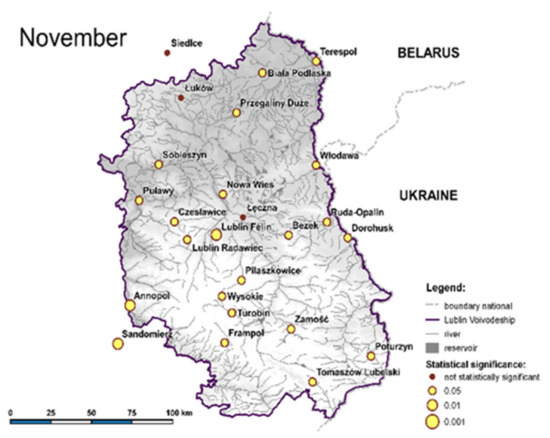
Figure A3.
Statistical significance of the trend (Z) for air temperature in the Lublin region in November (1971–2015).
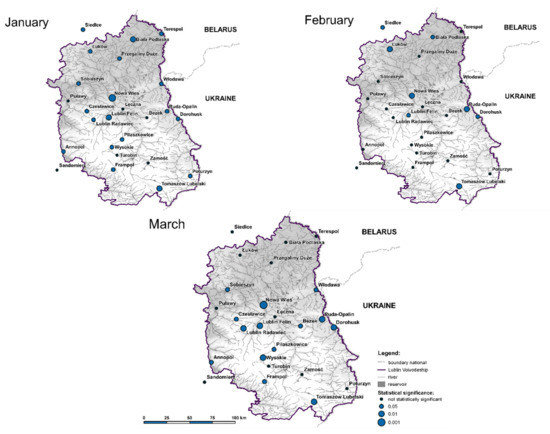
Figure A4.
Statistical significance of the trend (Z) for precipitation in the Lublin region in January, February and March (1971–2015).
References
- Parry, M.L.; Canziani, O.F.; Palutikof, P.J.; van der Linden, P.J.; Hanson, C.E. (Eds.) Intergovernmental Panel on Climate Change, Impacts, Adaptation and Vulnerability; Cambridge University Press: Cambridge, UK, 2007; Available online: https://www.ipcc.ch/site/assets/uploads/2018/03/ar4_wg2_full_report.pdf (accessed on 11 May 2021).
- Dellal, I.; McCarl, B.A. The economic impacts of drought on agriculture: The case of Turkey. In Economics of Drought and Drought Preparedness in a Climate Change Context. Zaragoza: CIHEAM/FAO/ICARDA/GDAR/CEIGRAM/MARM, (Options Méditerranéennes: Série A. Séminaires Méditerranéens); López-Francos, A., Ed.; CIHEAM: Paris, France, 2010; Volume 95, pp. 169–174. Available online: http://ressources.ciheam.org/om/pdf/a95/00801342.pdf (accessed on 1 May 2021).
- Ngaka, M. Drought preparedness, impact and response: A case of the Eastern Cape and Free State provinces of South Africa, Jàmbá. J. Disaster Risk Stud. 2012, 4, 47. [Google Scholar] [CrossRef]
- Paudel, B.; Acharya, B.S.; Ghimire, R.; Dahal, K.R.; Bista, P. Adapt ing agriculture to climate change and variability in Chitwan: Long term trends and farmers’ perceptions. Agric. Res. 2014, 3, 165–174. [Google Scholar] [CrossRef]
- Liang, X.Z.; Wu, Y.; Chambers, R.G.; Schmoldt, D.L.; Gao, W.; Liu, C.; Liu, Y.N.; Sun, C.; Kennedy, J.A. Determining climate efects on US to tal agricultural productivity. Proc. Natl. Acad. Sci. USA 2017, 114, E2285–E2292. [Google Scholar] [CrossRef]
- Brown, C.; Lall, U. Water and economic development: The role of variability and framework for resilience. Nat. Recourses Forum 2006, 30, 306–317. [Google Scholar] [CrossRef]
- Karl, T.R.; Melillo, J.M.; Peterson, T.C. (Eds.) Global Climate Change Impacts in the United States; Cambridge University Press: New York, NY, USA, 2009; p. 188. ISBN 978-0-521-14407-0. Available online: https://www.rosemonteis.us/sites/default/files/references/016726.pdf (accessed on 3 May 2021).
- Schmidhuber, J.; Tubiello, F.N. Global food security under climate change. Proc. Natl. Acad. Sci. USA 2007, 104, 19703–19708. [Google Scholar] [CrossRef] [PubMed]
- Wilhite, D.A. Drought as a Natural Hazard: Concepts and Definitions. In Drought: A Global Assessment; Routledge: London, UK, 2000; Volume 1, pp. 3–18. Available online: https://digitalcommons.unl.edu/cgi/viewcontent.cgi?article=1068&context=droughtfacpub (accessed on 3 May 2021).
- Dalezios, N.R.; Gobin, A.; Tarquis, A.M.; Eslamian, S. Agricultural drought indices: Combining crop, climate and soil factors. In Handbook of Drought and Water Scarcity: Principles of Drought and Water Scarcity; CRC Press: Boca Raton, FL, USA, 2017; ISBN 9781315404219. Available online: https://www.researchgate.net/publication/320689949_Agricultural_Drought_Indices_Combining_Crop_Climate_and_Soil_Factors/citations (accessed on 1 May 2021).
- Gerber, N.; Mirzabaev, A. Benefits of Action and Costs of Inaction: Drought Mitigation and Preparedness—A Literature Review; Integrated Drought Management Programme (IDMP) Working Paper 1; World Meteorological Organization (WMO) and Global Water Partnership (GWP): Geneva, Switzerland, 2017; Available online: https://www.droughtmanagement.info/literature/IDMP_BACI_WP.PDF (accessed on 3 May 2021).
- Dai, A. Drought under global warming: A review. Wiley Interdiscip. Rev. Clim. Change 2011, 2, 45–65. [Google Scholar] [CrossRef]
- Ziernicka-Wojtaszek, A. Cyrkulacyjne uwarunkowania susz rolniczych w województwie podkarpackim (Conditions of the atmospherric circulation agricultural dry in the podkarpackie voivodship). Infrastrukt. Ekol. Teren. Wiej. 2021, 2, 153–162. (In Polish) [Google Scholar]
- Bartoszek, K. Występowanie susz atmosferycznych w okolicy Lublina i ich uwarunkowania cyrkulacyjne (Occurrence of atmospheric droughts in the Lublin area and atmospheric circulation conditions). Ann. UMCS Sec. E Agric. 2014, 69, 49–61. (In Polish) [Google Scholar]
- Tomczyk, A.M.; Sulikowska, A. Heat waves in lowland Germany and their circulation-related conditions. Meteorol. Atmos. Phys. 2018, 130, 499–515. [Google Scholar] [CrossRef]
- Pereira, S.; Cordery, I.; Iacovides, I. Social, economic, cultural, legal and institutional constraints and issues. In Coping with Water Scarcity; Springer: Dordrecht, The Netherlands, 2009. [Google Scholar] [CrossRef]
- Bąk, B.; Łabędzki, L. Zależność między suszą meteorologiczną a rolniczą w uprawie buraka cukrowego w okresie wiosennym na glebach o różnej retencji użytecznej (Meteorological vs. agricultural drought and suger beet cultivation in spring season in soils of different available water retention). Acta Agrophys. 2008, 11, 335–344. (In Polish) [Google Scholar]
- Sarker, M.; Ahmed, S.; Alam, M.; Begum, D.; Kabir, T.; Jahan, R.; Haq, M.; Kabir, S. Development and Forecasting Drought Indices Using SPI (Standardized Precipitation Index) for Local Level Agricultural Water Management. Atmos. Clim. Sci. 2021, 11, 32–52. [Google Scholar] [CrossRef]
- Thuiller, W.S.; Lavorel, M.B.; Araujo, M.T.; Sykesi, I.; Prentice, C. Climate change threats to plant diversity in Europe. Proc. Natl. Acad. Sci. USA 2005, 102, 8245–8250. [Google Scholar] [CrossRef]
- Caldeira, M.; Lecomte, X.; David, T.; Pinto, J.; Bugalho, M.; Werner, C. Synergy of extreme drought and shrub invasion reduce ecosystem functioning and resilience in water-limited climates. Sci. Rep. 2015, 5, 15110. [Google Scholar] [CrossRef]
- Alizadeh, V.; Shokri, V.; Soltani, A.; Yousefi, M. Effects of Climate Change and Drought-Stress on Plant Physiology. Int. J. Adv. Biol. Biom. Res. 2015, 3, 38–42. [Google Scholar]
- Ray, R.L.; Fares, A.; Risch, R. Effects of Drought on Crop Production and Cropping Areas in Texas. Agric. Environ. Lett. 2018, 3, 170037. [Google Scholar] [CrossRef]
- Evans, N.; Baierl, A.; Semenov, M.A.; Gladders, P.; Fitt, B.D. Range and severity of a plant disease increased by global warming. J. R. Soc. Interface 2008, 5, 5525–5531. [Google Scholar] [CrossRef]
- Drenovsky, R.E.; Vo, D.; Graham, K.J.; Scow, K.M. Soil water content and organic carbon availability are major determinants of soil microbial community composition. Microb. Ecol. 2004, 48, 424–430. [Google Scholar] [CrossRef]
- Kardol, P.; Cregger, M.A.; Campany, C.E.; Classen, A.T. Soil ecosystem func-tioning under climate change: Plant species and community effects. Ecology 2010, 91, 767–781. [Google Scholar] [CrossRef]
- Geng, S.M.; Yan, D.H.; Zhang, T.X.; Weng, B.S.; Zhang, Z.B.; Qin, T.L. Effects of drought stress on agriculture soil. Nat. Hazards 2015, 75, 1997–2011. [Google Scholar] [CrossRef]
- Zhang, G.; Sui, X.; Li, Y.; Jia, M.; Zhongwu, W.Z.; Han, G.; Wang, L. The response of soil nematode fauna to climate drying and warming in Stipa breviflora desert steppe in Inner Mongolia. China J. Soils Sediments 2020, 20, 2166–2180. [Google Scholar] [CrossRef]
- Food and Agriculture Organization of the United Nations (FAO). Proactive Approaches to Drought Preparedness—Where are We Now and Where Do We Go From Here? FAO: Rome, Italy, 2019; Available online: http://www.fao.org/3/ca5794en/ca5794en.pdf (accessed on 3 May 2021).
- Troy, T.J.; Kipgen, C.; Pal, I. The impact of climate extremes and irrigation on US crop yields. Environ. Res. Lett. 2015, 10, 054013. [Google Scholar] [CrossRef]
- Nikulin, G.; Kjellström, E.; Hansson, U.; Strandberg, G.; Ullerstig, A. Evaluation and future projections of temperature, precipitation and wind extremes over Europe in an ensemble of regional climate simulations. Tellus A Dyn. Meteorol. Oceanogr. 2011, 63, 41–55. [Google Scholar] [CrossRef]
- Niedżwiedź, T.; Ustrnul, Z. Change of atmospheric circulation. In Climate Change in Poland: Past, Present and Future; Falarz, M., Ed.; Springer: Berlin/Heidelberg, Germany, 2021. [Google Scholar] [CrossRef]
- Bartoszek, K.; Krzyżewska, A. The atmospheric circulation conditions of the occurrence of heatwaves in Lublin, southeast Poland. Weather 2017, 72, 176–180. [Google Scholar] [CrossRef]
- Tomczyk, A.M.; Bednorz, E. Heat waves in Central Europe and tropospheric anomalies of temperature and geopotential heights. Int. J. Climatol. 2019, 39, 4189–4205. [Google Scholar] [CrossRef]
- Kożuchowski, K. Variations in hemispheric zonal index since 1899 and its relationship with air temperature. Int. J. Climatol. 1993, 13, 853–864. [Google Scholar] [CrossRef]
- Twardosz, R.; Niedźwiedź, T. Influence of synoptic situations on the precipitation in Kraków (Poland). Int. J. Climatol. 2001, 21, 467–481. [Google Scholar] [CrossRef]
- Degirmendžić, J.; Kożuchowski, K.; Żmudzka, E. Changes of air temperature and precipitation in Poland in the period 1951–2000 and their relationship to atmospheric circulation. Int. J. Climatol. 2004, 24, 291–310. [Google Scholar] [CrossRef]
- Falarz, M. Snow cover variability in Poland in relation to the macro- and mesoscale atmospheric circulation in the twentieth century. Int. J. Climatol. 2007, 27, 2069–2081. [Google Scholar] [CrossRef]
- Łupikasza, E. Relationships between occurrence of high precipitation and atmospheric circulation in Poland using different classifications of circulation types. Phys. Chem. Earth 2010, 35, 448–455. [Google Scholar] [CrossRef]
- Bartoszek, K.; Matuszko, D. The influence of atmospheric circulation over Central Europe on the long-term variability of sunshine duration and air temperature in Poland. Atmos. Res. 2021, 251, 105427. [Google Scholar] [CrossRef]
- Bąk, B.; Maszewski, R. Typy cyrkulacji atmosfery w regionie bydgosko-toruńskim podczas długotrwałej suszy meteorologicznej w latach 1989–1998 (Types of atmospheric circulation in the region Bydgoszcz-Toruń during long-time meteorological drought in the years 1989–1998). Woda Środow Obsz. Wiej 2012, 12, 17–29. (in Polish). [Google Scholar]
- Bąk, B.; Kejna, M.; Uscka-Kowalkowska, J. Susze meteorologiczne w rejonie stacji ZMŚP w Koniczynce (Pojezierze Chełmińskie) w latach 1951-2010 (Meteorological droughts in the region of the station of Integrated Environmental Monitoring in Koniczynka (Chełmno Lakeland) in the years 1951–2010). Woda Środow Obsz. Wiej 2012, 12, 19–28. (in Polish). [Google Scholar]
- Kondracki, J. Geografia Regionalna Polski (Regional Geography of Poland); Polskie Wydawnictwo Naukowe: Warszawa, Poland, 2000. (In Polish) [Google Scholar]
- Główny Inspektorat Ochrony Środowiska (Chef Inspectorate of Environmental Protection). Raporty Województwo Lubelskie (Reports Lublin Voivodeship). 2013. Available online: http://www.gios.gov.pl/images/dokumenty/pms/raporty/LUBELSKIE.pdf (accessed on 8 March 2021). (In Polish)
- Urząd Statystyczny w Lublinie (Statistical Office in Lublin). Rolnictwo w województwie lubelskim w 2019 roku (Agriculture in the Lubelskie Voivodeship in 2019). 2020. Available online: https://lublin.stat.gov.pl/publikacje-i-foldery/rolnictwo-lesnictwo/rolnictwo-w-wojewodztwie-lubelskim-w-2019-roku,1,14.html (accessed on 6 May 2021).
- Kaszewski, B. Warunki klimatyczne Lubelszczyzny (Climatic Conditions of the Lublin Region); UMCS: Lublin, Poland, 2008; p. 60. (In Polish) [Google Scholar]
- Węgrzyn, A.; Wojkowski, J.; Skowera, B. Rolnicze okresy termiczne na Lubelszczyźnie w latach 1981–2010 (Agricultural thermal seasons in the Lublin region in the period 1981–2010). Acta Agroph. 2017, 24, 535–551. (In Polish) [Google Scholar]
- Kaszewski, B.M.; Mrugała, S.; Warakomski, W. Klimat: Temperatura Powietrza i Opady Atmosferyczne Lubelszczyzny (1951–1990) (Climate: Air Temperature and Atmospheric Precipitation in the Lublin Region (1951–1990); Lubelskie Towarzystwo Naukowe: Lublin, Poland, 1995; p. 69. (In Polish) [Google Scholar]
- Kaszewski, B.M.; Bartoszek, K.; Gluza, A. Synoptic conditions of advection of arctic and tropical air masses over the Lublin region. Ann. UMCS Sec. B 2017, 7–26. (In Polish) [Google Scholar] [CrossRef]
- Bartoszek, K. Calendar of Circulation Types over the Lublin Region; Computer File; Maria Curie-Sklodowska University in Lublin, Department of Hydrology and Climatology: Lublin, Poland, 2019. [Google Scholar]
- Jenkinson, A.F.; Collinson, F.P. An Initial Climatology of Gales Over the North Sea. Meteorological Office, Synoptic Climatology Branch Memorandum 62, Bracknell, 1977, p. 18. Available online: https://www.scirp.org/reference/ReferencesPapers.aspx?ReferenceID=2083549 (accessed on 2 November 2021).
- Bartoszek, K. The main characteristics of atmospheric circulation over East-Central Europe from 1871 to 2010. Meteorol. Atmos. Phys. 2017, 129, 113–129. [Google Scholar] [CrossRef]
- Kalnay, E.; Kanamistu, M.; Kistler, R.; Collins, W.; Deaven, D.; Gandin, L.; Iredell, M.; Saha, S.; White, G.; Woollen, J.; et al. The NMC/NCAR 40-Year Reanalysis Project. Bull. Am. Met. Soc. 1996, 77, 437–471. [Google Scholar] [CrossRef]
- Ped, D.A. The analysis of two summer seasons with different weather conditions. Tr. GNIC 1977, 171, 3–19. [Google Scholar]
- Meshcherskaya, A.V.; Blazhevich, V.G. The Drought and Excessive Moisture Indices in a Historical Perspective in the Principal Grain-Producing Regions of the Former Soviet Union. J. Clim. 1997, 10, 2670–2682. [Google Scholar] [CrossRef]
- Tri, D.Q.; Dat, T.T.; Truong, D.D. Application of Meteorological and Hydrological Drought Indices to Establish Drought Classification Maps of the Ba River Basin in Vietnam. Hydrology 2019, 6, 49. [Google Scholar] [CrossRef]
- Koleva, E.; Alexandrov, V. Drought in the Bulgarian low regions during the 20th century. Theor. Appl. Climatol. 2008, 92, 113–120. [Google Scholar] [CrossRef]
- Podstawczyńska, A. Air Temperature and Precipitation in the Łódź Region in the Last Century [In] Torfowisko Żabieniec: Warunki Naturalne, Rozwój i Zapis Zmian Paleoekologicznych w Jego Osadach. Available online: http://meteo.geo.uni.lodz.pl/ap/pdf/2010_Zabieniec.pdf (accessed on 2 November 2021). (In Polish).
- Kopcińska, J.; Skowera, B.; Wojkowski, J.; Zając, E.; Ziernicka-Wojtaszek, A. Identification of the dry and the wet months in the Opolskie voivodeship nn the basis of chosen climate indexes (1981–2010). Infrastrukt. I Ekol. Teren. Wiej./Infrastruct. Ecol. Rural Areas 2018, II/1, 421–434. [Google Scholar] [CrossRef]
- Skowera, B.; Wojkowski, J.; Ziernicka-Wojtaszek, A. Warunki termiczno-opadowe na obszarze województwa opolskiego w latach 1981–2010 (The thermal-precipitation conditions in the Opole voivodeship in the 1981–2010 period). Infrastrukt. Ekol. Teren. Wiej. 2016, 3, 919–934. (In Polish) [Google Scholar] [CrossRef]
- Hirsch, R.M.; Slack, J.R.; Smith, R.A. Techniques of Trend Analysis for Monthly Water Quality Data. Water Resour. Res. 1982, 18, 107–121. [Google Scholar] [CrossRef]
- Helsel, D.R.; Hirsch, R.M. Statistical Methods in Water Resources; Elsevier: Amsterdam, The Netherlands, 1992. [Google Scholar]
- Salmi, T.; Määttä, A.; Anttila, P.; Ruoho-Airola, T.; Amnell, T. Detecting Trends of Annual Values of Atmospheric Pollutants by the Mann-Kendall Test and Sen’s Slope Estimates—The Excel Template Application MAKESENS. Publications on Air Quality. Available online: https://www.academia.edu/19393286/Detecting_Trends_of_Annual_Values_of_Atmospheric_Pollutants_by_the_Mann_Kendall_Test_and_Sens_Solpe_Estimates_the_Excel_Template_Application_MAKESENS (accessed on 4 March 2021).
- Rozpondek, R.; Wancisiewicz, K. Stosowanie wybranych metod generowania regularnych modeli terenu z lotniczego skaningu laserowego do badań środowiskowych (Application of selected methods of generating regular terrain models from airborne laser scanning for environmental research). Inżynieria Ochr. Środowiska 2017, 20, 83–95. (In Polish) [Google Scholar] [CrossRef]
- Łabędzki, L. Problematyka susz w Polsce (Droughts problems in Poland). Woda Środowisko Obsz. Wiej. 2004, 4, 47–66. (In Polish) [Google Scholar]
- Intergovernmental Panel on Climate Change. Summary for policymakers. In Climate Change 2013—The Physical Science Basis: Working Group I Contribution to the Fifth Assessment Report of the Intergovernmental Panel on Climate Change; Cambridge University Press: Cambridge, UK, 2014; pp. 1–30. [Google Scholar] [CrossRef]
- Instytut Geodezji i Kartografii (Institute of Geodesy and Cartography). Monitorowanie Wzrostu Roślin Uprawnych i Prognozowanie Plonów w Polsce (Crop Growth Monitoring and Yield Forecasting in Poland). 2021. Available online: http://www.igik.edu.pl/pl/teledetekcja-prognozowanie-plonow (accessed on 4 May 2021). (In Polish).
- Szyga-Pluta, K. Zmienność występowania susz w okresie wegetacyjnym w Polsce w latach 1966–2015 (Variability of drought occurrence during growing season in Poland in years 1966–2015). Przegl. Geofiz. 2018, 63, 51–68. (In Polish) [Google Scholar]
- Bartoszek, K.; Skiba, D. Circulation types classification for hourly precipitation events in Lublin (East Poland). Open Geosci. 2016, 8, 214–230. [Google Scholar] [CrossRef]
- Bartoszek, K. Zmienność wskaźników cyrkulacji atmosferycznej nad obszarem Lubelszczyzny i związek temperatury powietrza i opadów atmosferycznych z tymi wskaźnikami (Temporal variability of atmospheric circulation indices over the Lublin region and their relationships with air temperature and precipitation). Pr. Geogr. 2017, 150, 61–78. (In Polish) [Google Scholar] [CrossRef][Green Version]
- Wibig, J. Hot Days and Heat Waves in Poland in the period 1951–2019 and the Circulation Factors Favoring the Most Extreme of Them. Atmoshere 2021, 12, 340. [Google Scholar] [CrossRef]
- Hoy, A.; Sepp, M.; Matschullat, J. Atmospheric circulation variability in Europe and northern Asia (1901 to 2010). Theor. Appl. Climatol. 2013, 113, 105–126. [Google Scholar] [CrossRef]
- Fleig, A.K.; Tallaksen, L.M.; James, P.; Hisdal, H.; Stahl, K. Attribution of European precipitation and temperature trends to changes in synoptic circulation. Hydrol. Earth Syst. Sci. 2015, 19, 3093–3107. [Google Scholar] [CrossRef]
- Zampieri, M.; D’Andrea, F.; Vautard, R.; Ciais, P.; de Noblet-Ducoudré, N.; Yiou, P. Hot European Summers and the role of soil moisture in the propagation of Mediterranean drought. J. Clim. 2009, 22, 4747–4758. [Google Scholar] [CrossRef]
- Kożuchowski, K.; Żmudzka, E. Ocieplanie w Polsce, skala i sezon rozkładowy temperatury zmian w połowie XX wieku (The warming in Poland: The range and seasonality of the changes in air temperature in the second half of 20th century). Przegl. Geofiz. 2001, 46, 81–90. (In Polish) [Google Scholar]
- Michalska, B. Tendencje zmian temperatury powietrza w Polsce (Tendencies of air temperature changes in Poland). Pr. Studia Geogr. 2011, 47, 67–75. (In Polish) [Google Scholar]
- Kundzewicz, Z.W. Zmiany klimatu, ich przyczyny i skutki—Obserwacje i projekcje (Climate changes, their reasons and effects—Observations and projections). Landform Anal. 2011, 15, 39–49. (In Polish) [Google Scholar]
- Skowera, B.; Kopcińska, J.; Kopeć, B. Changes in thermal and precipitationconditions in Poland in 1971–2010. Ann. Wars. Univ. Life Sci. SGGW Land Reclam. 2014, 46, 153–162. [Google Scholar] [CrossRef]
- Twardosz, R. Zmiany częstości anomalii termicznych w Polsce w latach 1951–2015 (Change in the frequency of temperature anomalies in Poland, 1951–2015). Pol. J. Agron. 2017, 31, 3–10. (In Polish) [Google Scholar]
- Wypych, A.; Sulikowska, A.; Ustrnul, Z.; Czekierda, D. Variability of growing degree days in Poland in response to ongoing climate changes in Europe. Int. J. Biometeorol. 2017, 61, 49–59. [Google Scholar] [CrossRef]
- Kossowska-Cezak, U. Zmiany termicznych pór roku w Warszawie w okresie 1933–2004 (Changes of the thermic seasons in Warssaw in the period 1933–2004). Prz. Geof. 2005, 50, 265–277. (In Polish) [Google Scholar]
- Wójcik, M.; Miętus, M. Niektóre cechy wieloletniej zmienności temperatury powietrza w Polsce (1951–2010) (Some features of long-term variability in air temperature in Poland (1951–2010). Prz. Geograf. 2014, 86, 339–364. [Google Scholar] [CrossRef]
- Ziernicka-Wojtaszek, A. Warunki meteorologiczne wegetacji roślin uprawnych na obszarze województwa podkarpackiego w latach 1981–2016 (Meteorological conditions pertaining to the vegetation of key crops in the subcarpathian voivodeship 1981–2016). Zesz. Probl. Postępów Nauk Rol. SGGW 2017, 590, 103–110. (In Polish) [Google Scholar] [CrossRef]
- Hoy, A.; Hänsel, S.; Skalak, P.; Ustrnul, Z.; Bochníček, O. The extreme European summer of 2015 in a long-term perspective. Int. J. Climatol. 2016, 37, 943–962. [Google Scholar] [CrossRef]
- Lhotka, O.; Kyselý, J. Characterizing joint effects of spatial extent, temperature magnitude and duration of heat waves and cold spells over Central Europe. Int. J. Climatol. 2015, 35, 1232–1244. [Google Scholar] [CrossRef]
- Tomczyk, A.M.; Bednorz, E. Heat waves in Central Europe and their circulation conditions. Int. J. Climatol. 2016, 36, 770–782. [Google Scholar] [CrossRef]
- Graczyk, D.; Pińskwar, I.; Kundzewicz, Z.W.; Hov, Ø.; Førland, E.J.; Szwed, M.; Choryński, A. The heat goes on—Changes in indices of hot extremes in Poland. Theor. Appl. Climatol. 2017, 129, 459–471. [Google Scholar] [CrossRef][Green Version]
- Mittler, R.; Blumwald, E. Genetic engineering for modern agriculture: Challenges and perspectives. Ann. Rev. Plant Biol. 2010, 61, 443–462. [Google Scholar] [CrossRef]
- Błoński, J.; Błażejczyk, K. Wpływ procesu globalizacji na rozwój rolnictwa na świecie (The impact of the globalization process on the development of agriculture in the world). In Globalne Zmiany Klimatu i ich Wpływ na Światowe Rolnictwo (Global Climate Change and its Impact on World Agriculture); Dybowski, G., Ed.; IERiGŻ-PIB: Warszawa, Poland, 2005; Available online: https://docplayer.pl/5509142-Wplyw-procesu-globalizacji-na-rozwoj-rolnictwa-na-swiecie-nr-17.html (accessed on 4 March 2021). (In Polish)
- Hatfield, J.L.; Boote, K.J.; Kimball, B.A.; Wolfe, D.W.; Ort, D.R.; Izaurralde, C.R.; Thomson, A.M.; Morgan, J.A.; Polley, H.W.; Fay, P.A.; et al. Agriculture. In The Effects of Climate Change on Agriculture, Land Resources, Water Resources, and Biodiversity; A Report by the U.S. Climate Change Science Program and the Subcommittee on Global Change Research; U.S. Global Change Research Program: Washington, DC, USA, 2008. [Google Scholar]
- Hatfield, J.L.; Boote, K.J.; Kimball, B.A.; Ziska, L.H.; Izaurralde, R.C.; Ort, D.; Thomson, A.M.; Wolfe, D.W. Climate impacts on agriculture: Implications for cropproduction. Agron. J. 2011, 103, 351–370. [Google Scholar] [CrossRef]
- Hatfield, J.L.; Prueger, J.H. Temperature Extremes: Effect on Plant Growth and Development. Weather Clim. Extrem. 2015, 10, 4–10. [Google Scholar] [CrossRef]
- Wang, X.; Piao, S.; Ciais, P.; Li, J.; Friedlingstein, P.; Koven, C.; Chen, A. Spring temperature change and its implication in the change of vegetation growth in North America from 1982 to 2006. Proc. Natl. Acad. Sci. USA 2006, 108, 1240–1245. [Google Scholar] [CrossRef]
- Hasanuzzaman, M.; Nahar, K.; Gill, S.S.; Fujita, M. Drought stress responses in plants, oxidative stress, and antioxidant defense. In Climate Change and Plant Abiotic Stress Tolerance; Tuteja, N., Gill, S.S., Eds.; John Wiley & Sons: Weinheim, Germany, 2013; pp. 209–250. [Google Scholar] [CrossRef]
- Kalbarczyk, E. Niedobory opadów atmosferycznych ograniczające plony pszenżyta jarego w północno-zachodniej Polsce (Precipitation deficiency limiting the yields of spring triticale in north-western Poland). Acta Agrophys. 2008, 11, 419–428. [Google Scholar]
- Agricultural Drought Monitoring System (ADMS). Available online: https://susza.iung.pulawy.pl/ (accessed on 10 May 2021).
Publisher’s Note: MDPI stays neutral with regard to jurisdictional claims in published maps and institutional affiliations. |
© 2021 by the authors. Licensee MDPI, Basel, Switzerland. This article is an open access article distributed under the terms and conditions of the Creative Commons Attribution (CC BY) license (https://creativecommons.org/licenses/by/4.0/).